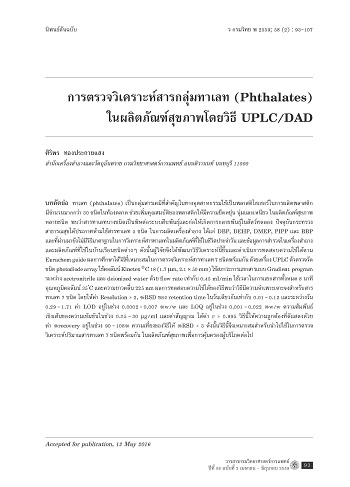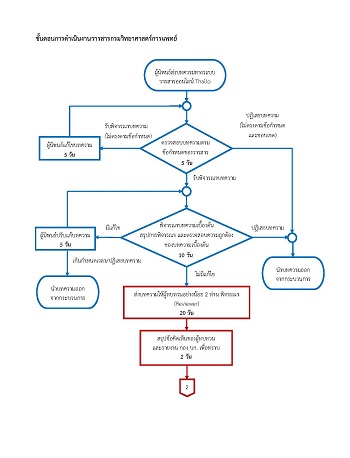Simultaneously Quantitative of Phthalates in Health Care Products by UPLC/DAD
Keywords:
phthalates, UPLC, cosmetic product, household productAbstract
Phthalates are a class of industrial chemicals comprising about 30 commercial products which mostly used as plasticizer to enhance the flexible and soften of plastic. Presently, phthalates are used in variety of health care products both cosmetic and household products, thus they are widespread to human exposure. Toxicities of phthalates are concerned due to their mutagenicity in vitro and induce reproductive and developmental health effects in animals. Now, Thailand’s the Ministry of Public Health is banning five of phthalates i.e. DBP, DMEP, DEHP, PIPP and BBP. However, we still lack of the situation data of phthalates presented in health care products. This study is for the development of simultaneously determination of seven phthalates by UPLC/DAD technique and validation the method following EURACHEM Guideline. The study Kinetex ®C-18 column (1.7 μm, 2.1 × 50 mm) was used. The separation was gradient programmed of the ratio of acetronitrile and deionized water with flow rate 0.45 ml/min, column temperature 35 oC, λmax = 225 nm and running time of 8 min. The validation results showed a good selectivity of seven phthalates with resolution > 2, %RSD (n =10) of within and between run were 0.01 – 0.12% and 0.29 – 1.71%. LOD and LOQ were in the range of 0.0002 – 0.007 %w/w and LOQ 0.001 – 0.022 %w/w. Linearity of the method was in the range of 0.05 – 30 μg/ml with correlation coefficient, r ≥ 0.995. Accuracy was presented as %recovery wihtin 90 – 108. The precision was presented as % RSD of peak area which was less than < 3% (n=10). The results showed that this method was valid appropriately for determination of seven phthalates in health care products subjecting for consumer protection.
References
Babich MA. Overview of dialkyl ortho-phthalates. Bethesda, MD: United States Consumer Product Safety Commission. 2010.
Kamrin MA. Phthalate risks, phthalate regulation, and public health: a review. J Toxicology Environ Health-Part B 2009; 12:157–74.
International Agency for Research on Cancer. Some industrial chemicals. IARC Monographs on the evaluation of carcinogenic risks to humans77, Lyon, France: IARC; 2000.
Dong CH, Liu YF, Yang WF, Sun XL, Wang GQ. Simultaneous determination of phthalate plasticizers in PVC packaging materials using homogeneous-ultrasonic extraction-GC-MS assisted with continuous wavelet transform. Anal. Methods. 2013; 5: 4513-7.
Wenzl T. Methods for the determination of phthalates in food. Outcome of a survey conducted among European food control laboratories [online]. 2009. [cited 2015 Feb 9]; [5 screens]. Available from: https://www.bezpecnostpotravin.cz/UserFiles/File/Publikace/ftalaty.pdf
Peters RJB. Chemical additives in consumer products. TNO-report R&I-A R 2005/066. The Netherlands: TNO Environment and Geosciences. 2005.
Gimeno P, Maggio AF, Bousquet C, Quoirez A, Civade C, Bonnet PA. Analytical method for the identification and assay of 12 phthalates in cosmetic products: application of the ISO 12787 international standard “Cosmetics–Analytical methods–Validation criteria for analytical results using chromatographic techniques”.J Chromatogr A2012; 1253: 144–53.
Cacho JI, Campillo N, Viñas P, Hernández-Córdoba M. Direct sample introduction gas chromatography and massspectrometry for the determination of phthalate esters in cleaning products. J Chromatogr A, 2015; 1380, 156–61.
Su R, Zhao X, Li Z, Jia Q, Liu P, Jia J. Poly (methacrylic acid-co-ethylene glycol dimethacrylate) monolith microextraction coupled with high performance liquid chromatography for the determination of phthalate esters in cosmetics. Anal Chim Acta, 2010; 676(1–2): 103-8.
Eurachem. Eurachem Guide: The fitness for purpose of analytical methods-A laboratory guide to method validation and related topics, 2nd ed [online]. 2014. [cited 2015 Jan 20]; [70 screens]. Available from: URL: https://www.eurachem.org/images/stories/Guides/pdf/MV_guide_2nd_ed_EN.pdf.
Eurachem. EURACHEM/CITAC Guide CG 4. Quantifying uncertainty in analytical measurement, 3rd ed [online]. 2012. [cited 2016 Feb 10]; Available from: URL: https://www.eurachem.org/images/stories/Guides/pdf/QUAM2012_P1.pdf
Wu T, Wang C, Wang X, Xiao H, Ma Q, Zhang Q. Comparison of UPLC and HPLC for analysis of 12 phthalates. Chromatographia, 2008; 68, 803-6.
Koo HJ, Lee BM. Estimated exposure to phthalates in cosmetics and risk assessment. J Toxicol Environ Health A 2004; 67(23-24): 1901–14.
Hubinger JC. A survey of phthalate esters in consumer cosmetic products. J Cosmet Sci. 2010; 61(6):457-65.

Downloads
Published
How to Cite
Issue
Section
License

This work is licensed under a Creative Commons Attribution-NonCommercial-NoDerivatives 4.0 International License.



